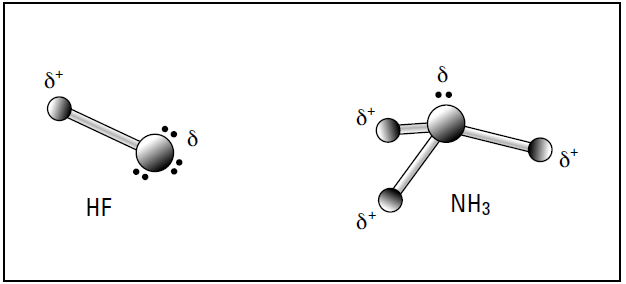


 علم الكيمياء
علم الكيمياء 
 الكيمياء التحليلية
الكيمياء التحليلية 
 الكيمياء الحياتية
الكيمياء الحياتية 
 الكيمياء العضوية
الكيمياء العضوية 
 الكيمياء الفيزيائية
الكيمياء الفيزيائية
 الكيمياء اللاعضوية
الكيمياء اللاعضوية 
 مواضيع اخرى في الكيمياء
مواضيع اخرى في الكيمياء
 الكيمياء الصناعية
الكيمياء الصناعية |
Read More
Date: 29-6-2020
Date: 3-1-2017
Date: 23-2-2018
|
Polar covalent bonding: Creating partial charges
If the two atoms involved in the covalent bond are not the same, the bonding pair of electrons is pulled toward one atom, with that atom taking on a slight (partial) negative charge and the other atom taking on a partial positive charge.
In most cases, the molecule has a positive end and a negative charge. end, called a dipole (think of a magnet). Figure 1-1 shows a couple of examples of molecules in which dipoles have formed. (The δ symbol by the charges is the lowercase Greek letter delta, and it refers to a partial charge.)

Figure 1-1: Polar covalent bonding in HF and NH3
In hydrogen fluoride (HF), the bonding electron pair is pulled much closer to the fluorine atom than to the hydrogen atom, so the fluorine end becomes partially negatively charged and the hydrogen end becomes partially positively charged. The same thing takes place in ammonia (NH3): The nitrogen has a greater electronegativity than hydrogen, so the bonding pairs of electrons are more attracted to it than to the hydrogen atoms. The nitrogen atom takes on a partial negative charge, and each hydrogen atom takes on a partial positive charge.
The presence of a polar covalent bond explains why some substances act the way they do in a chemical reaction: Because a polar molecule has a positive end and a negative end, it can attract the part of another molecule that has the opposite charge. In addition, a polar covalent molecule can act as a weak electrolyte because a polar covalent bond allows the substance to act as a conductor. So if a chemist wants a material to act as a good insulator (a device used to separate conductors), he or she looks for a material with as weak of a polar covalent bond as possible.



|
|
|
|
دراسة: حفنة من الجوز يوميا تحميك من سرطان القولون
|
|
|
|
|
|
|
تنشيط أول مفاعل ملح منصهر يستعمل الثوريوم في العالم.. سباق "الأرنب والسلحفاة"
|
|
|
|
|
|
|
الطلبة المشاركون: مسابقة فنِّ الخطابة تمثل فرصة للتنافس الإبداعي وتنمية المهارات
|
|
|